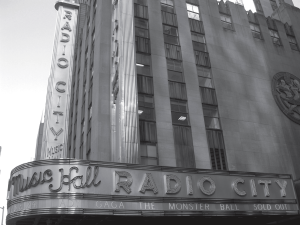Is Roxy the ghost in residence at Radio City Music Hall?
Radio City Music Hall opened in 1932 as the largest theater in New York City. It occupied a full city block. What better way to use the piece of property, valued at $91 million, on which John D. Rockefeller had a twenty-four-year lease? Rockefeller sought the help of Samuel Lionel Rothafel to bring this theater to a profitable life in spite of the Great Depression. “Roxy,” as Rothafel was nicknamed, possessed “theatrical genius by employing an innovative combination of vaudeville, movies and razzle-dazzle decor to revive struggling theatres across America,” according to Radio City’s Web site. The rainbow-arched backdrop behind the stage provides the look of sunrise and sunset as seen from the deck of a ship. The balcony represents the ship’s deck. There are no support columns, so every seat is a good seat in this theater.
Complementing Roxy’s showmanship was the interior design talent of then-unknown Donald Deskey, who created the Grand Foyer, along with all the other smoking rooms, the lounges, and the Diamond Lobby. He used basic materials like cork, Bakelite, and aluminum to stunning effect.
Take a tour of Radio City Music Hall

My mother and I took the tour of Radio City Music Hall, which is well worth the time and money. You may take pictures, but no recording of any kind is allowed, so you won’t be able to collect EVPs. I managed to capture an orb in the Grand Foyer. It might be genuine, as none of my other photos contained orbs. The tour lasts about an hour; plan to wear comfy walking shoes or sneakers, because the tour goes from the backstage hydraulics up to Roxy’s suite, which includes climbing stairs and plenty of walking. At the conclusion of the tour, I decided to follow up on the ghost of Roxy story I had read about in other ghost-related books. I asked the guide if he had ever encountered the ghost of Roxy. His answer was simply, “No.” In fact, he remarked that I was the first person who had ever asked him about Roxy as a ghost.
I spoke with Diane Jaust, archivist for Radio City, and she was intrigued by the story, but she said she had no information on Roxy’s ghost. She went into research mode and tracked down former Rockettes and ballet dancers from the 1940s, 1950s, and 1960s. Everyone she spoke with said they never encountered his ghost, nor had they ever felt the theater was haunted. I heard from one of the former ballerinas, Janice Herbert. She said, “I called all the dancers I know who performed at Radio City, and the answer to Roxy’s ghost being there was ‘No,’ with a lot of laughter.” My inquiries had yielded nothing, but I’m glad they at least provided some entertainment.
Yet, according to Dr. Philip Schoenberg, founder and head tour guide for Ghosts of New York Walking Tours, Roxy has been seen at 1260 Sixth Avenue in Rockefeller Center “on opening nights . . . accompanied by a glamorous female companion.” Other reports say that Roxy’s ghost, along with a beautiful lady on his arm, has been seen walking down the aisle toward their seats, vanishing before reaching them. Places as old and as rich in history as Radio City Music Hall typically yield some sort of residual haunting or ghost. This is one of those spots that requires the paranormal investigator to take a closer look. Raise the great curtain on the paranormal and decide for yourself.
About the author
L’Aura Hladik, author of Ghosthunting New York City also investigated the Cherry Lane Theater which we invite you to read. L’Aura Hladik is also the author of Ghosthunting New Jersey and the founder of the New Jersey Ghost Hunters Society.